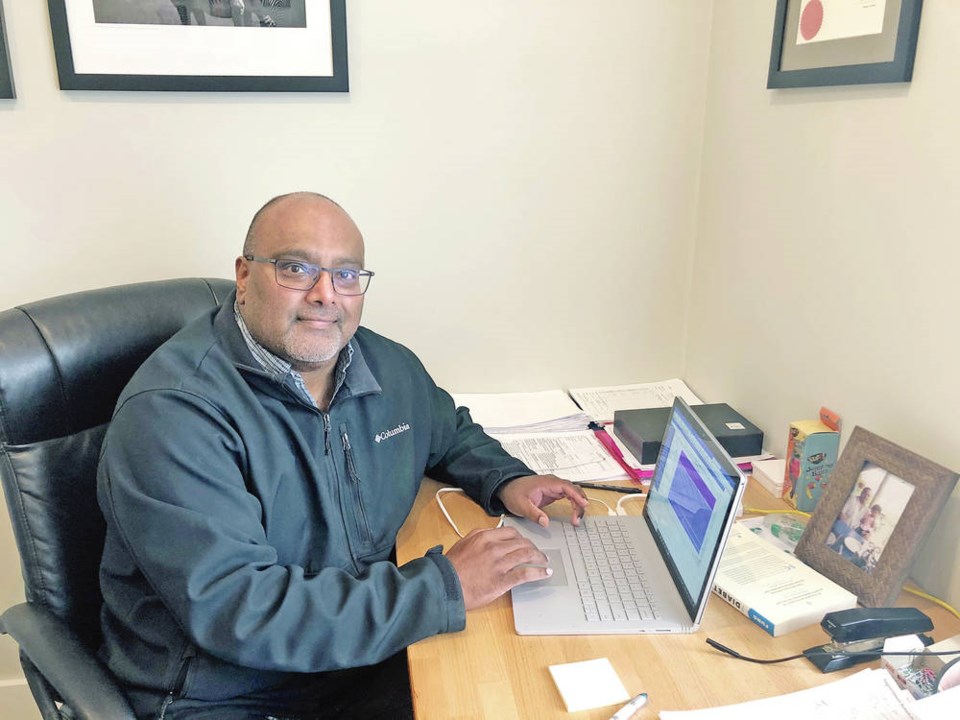In two months, Dr. Prean Armogam — who has served as a physician in the small North Island town of Port McNeill for 15 years — will be the area’s sole doctor, he says.
When fellow physician Dr. Joy Mijares leaves at the end of April, the area will be down to one physician. The next closest doctor is 40 kilometres away in Port Hardy, where there are six.
“For me, as the last man standing in April, it’s very daunting and worrisome,” Armogam said. “I think people are going to panic, and rightly so.”
Armogam, a South African who came to Port McNeill from the United Kingdom 15 years ago, is in a two-physician practice that serves the town of Port McNeill, home to roughly 3,500 people, along with the greater Mount Waddington area and isolated areas including Kincome Inlet, Gilford Island, Alert Bay, Rivers Inlet, Zeballos and Sointula.
In all, the practice has a roster of 5,500 patients.
In addition to the two-doctor practice, Port McNeill has a small hospital for emergency care, staffed by acute-care nurses employed by Island Health.
“If Dr. Armogam is the only one left, he can either be at the clinic, or he can be at the hospital — he can’t be in both places,” Mayor Gaby Wickstrom said. “It’s not an option for us not to have a clinic here or hospital here. We service too broad an area.”
Port McNeill council and Island Health spoke Thursday about using locums to fill the immediate need when Mijares leaves, Wickstrom said.
The health authority and council also talked about a new model of health care in Port McNeill, including a team-based approach — where everyone from nurses to nurse practitioners and physiotherapists works alongside physicians in one space — or a model where the health authority runs the business, allowing the doctors to focus on practising medicine.
Armogam says he likes the latter idea. “I just want to be a doctor,” he said. “I’m pretty sure other people could do the business-management stuff better than us.”
Wickstrom hopes Port McNeill could be the location for a pilot project. “We’re willing to work together and in whatever capacity we can.”
Island Health says it has been exploring care options for the residents of Port McNeill for several months, for both the short and long term.
In 2012, the clinic partnered with Island Health to provide an integrated model of care, a project that is ongoing. The practice has a fixed primary-care nurse and social worker with a rotating dietitian and mental-health counsellors.
Five years ago, it even had three other doctors — one of whom was Mijares — all international medical graduates completing their residencies in B.C. Such graduates are required to work for two years in an under-serviced area, but two did not fulfil their obligation of two full years and the province didn’t enforce it, Armogam said.
Despite pleas to the province and health authority, the town has not received these sponsored doctors again.
Last summer, doctors raised the red flag, saying a crisis was imminent and the business model was not sustainable.
Armogam, 49, had a health scare two years ago — a rare syndrome that nearly cost him his arm and life — and as a result was set to retire last May, but because of the pandemic and talk of change, he deferred stepping down.
“It was flagged a long time ago but the whole inertia and and the lack of a response has just kind of left us in this position,” said Armogam, who works long hours, starting with waking up at 2 a.m. most mornings to do paperwork until 6 a.m.
At 7 a.m., he catches a ferry to Sointula, a small village on Malcolm Island where he works until about 11 a.m. Then he returns to Port McNeill to do phone visits for patients in the community and surrounding areas.
“I only go to bed at 10 p.m. and then I’m up again at 2 a.m.”
There are many days that he holds clinics for primary-care patients out of the emergency department, where he treats urgent cases, while also on 24-hour on-call duty, as does his physician partner.
“This has been happening now for probably the last six to eight months,” said Armogam, who is married and has four grown children who have left home. “It’s so hard.”
“We just feel unsupported at the moment. This was avoidable, if our voices were heard. People of our region and the providers of our region have been invisible for quite a while.”
The answer might lie in a similar model to the one already operating in Port Hardy, where six doctors work in an Island Health-owned and operated clinic.
Dr. Granger Avery, who opened the private clinic that Armogam now runs in 1974, said the health-care system in the town works best with five doctors and a trainee resident and students. “That’s when we’re really humming.”
Avery, who is now retired, supports the idea of the health authority owning and operating the medical clinic, employing nurses and nurse practitioners to treat many of the patients, while allowing doctors to do the so-called detective work of doctoring that is professionally rewarding for them and meaningful to the patient.
He said it’s evident something has to change, and team-based care could work in the small and friendly town of Port McNeill. “It could be a template.”
As for Armogam, he says the province needs to shift its health-care focus to rural areas. “Losing a rural physician is infinitely greater than losing a physician or not having a physician in an urban area.”
ceharnett@timescolonist.com



